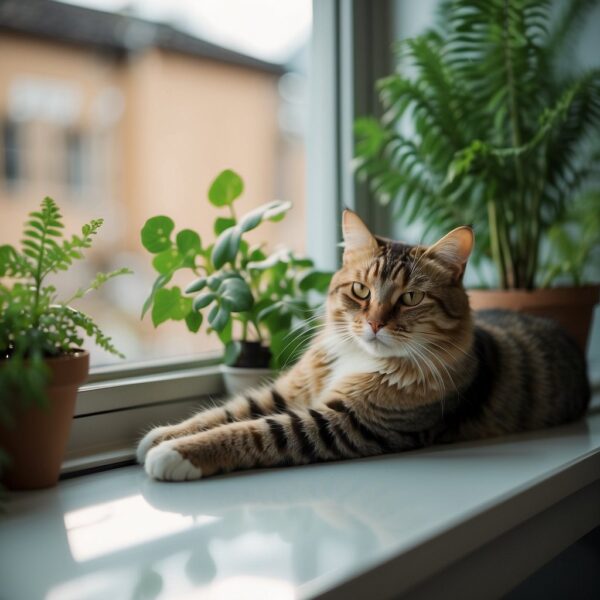
Valerian root for Cats: Natural Calming Remedy
Valerian root, a plant with a notable history of use in human herbal remedies, is becoming increasingly popular among cat parents for its unique effects on feline behavior. Unlike its soothing effect on humans, Valerian exerts a stimulating influence on cats, akin to the well-known response many felines have to catnip. This response is due to actinidine, a compound found in Valerian that can induce a state of playfulness and euphoria in cats.
While catnip, whose efficacy is attributed to the compound nepetalactone, may be the most famous herb for generating feline frolic, not all cats are affected by it. For those cats that remain indifferent to catnip, Valerian can be a safe alternative. Additionally, other substances like silvervine and honeysuckle can also be considered as alternatives, offering a similar pleasure-inducing experience. When introducing Valerian to cats, it’s important to consider the appropriate dosage and method to ensure a positive experience for the pet.
Key Takeaways
- Valerian has a unique, stimulating effect on cats, which contrasts its calming effect in humans.
- It can serve as an alternative to catnip for cats that may not react to it.
- Safe dosing and proper presentation of Valerian ensure a beneficial experience for cats.
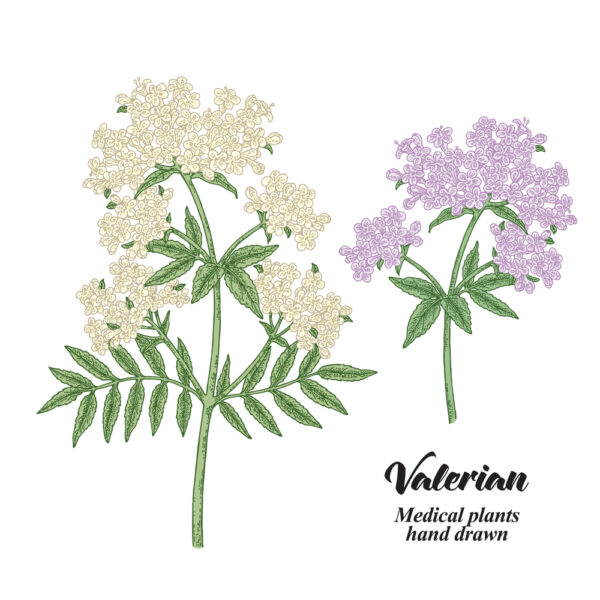
Understanding Valerian and Its Effects on Cats
Valerian root, scientifically known as Valeriana officinalis, has a markedly different effect on cats compared to humans. Although it typically calms humans, in cats, it can act as a stimulant causing noticeable behavioral changes.
What Is Valerian?
Valeriana officinalis, commonly referred to as valerian, is a perennial plant known for its sweet-smelling pink or white flowers. It’s often utilized in herbal medicine, primarily for its sedative qualities in humans. However, for cats, the root of this plant is where the intriguing effect lies.
Chemical Components and Action Mechanism
The root of valerian contains several compounds, including actinidine, which is a strong cat attractant. Another significant compound is valerenic acid, which targets the GABA (gamma-aminobutyric acid) neurotransmitter system in humans, promoting calmness. In felines, the interaction with these neurotransmitters results in stimulation, often manifesting as euphoric activity similar to the excitement observed with catnip exposure.
Comparing Valerian to Other Stimulants
Valerian can be likened to catnip due to its ability to induce a state of euphoria although not all cats may respond to it. Like catnip, which contains nepetalactone, valerian’s actinidine impacts a proportion of the feline population who possess a genetic sensitivity to such compounds, leading to a range of behaviors from playful hyperactivity to seemingly blissful states.
Health Benefits of Valerian for Cats
The root is renowned for its sedative properties in humans, and when it comes to feline health, it offers similar benefits. Specifically, it can induce relaxation, alleviate anxiety, and promote sleep for cats.
Anxiety and Stress Relief
Valerian root contains compounds that can act as a natural stress reliever for cats. When cats encounter this root, it can trigger a sense of pleasure and well-being, similar to their response to catnip. This can reduce feelings of anxiety and promote a calm environment for cats who may be stressed or agitated.
Sleep Aid and Insomnia
For felines experiencing sleep disturbances or insomnia, the root might serve as a gentle sleep aid. The relaxing effects of valerian can encourage a restful state, which can help cats that have trouble settling down to sleep more easily and peacefully.
Physical Health Impacts
While research on the direct physical health benefits of the root for cats is limited, the stress relief and calming effects can contribute to overall wellness. A cat that is less stressed may experience fewer stress-related physical issues and exhibit a more balanced behavior.
- Note on Dosage: It’s imperative that cat parents consult with a veterinarian to determine the appropriate form and dosage of valerian root for their individual cats to ensure safety and efficacy
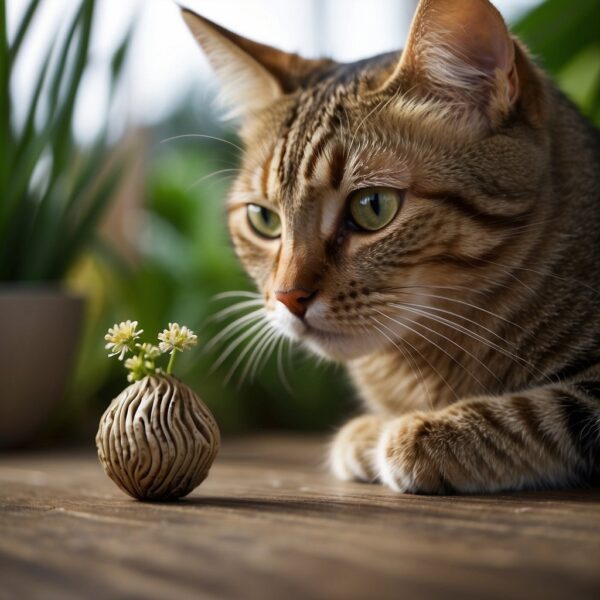
Practical Uses and Applications
Valerian can be utilized in various forms to promote playfulness and exercise in cats, contributing to their overall enrichment. Its application ranges from direct supplementation to integration within play environments.
Valerian in Different Forms
Valerian is available for cats in several formats such as tinctures, capsules, and infused in toys.
- Tinctures: A few drops of valerian tincture can be added to a cat’s water or food. The tincture should be used in moderation to avoid overstimulation.
- Capsules: These can be mixed with food for easier ingestion if a cat is averse to direct supplementation.
- Toys: Valerian toys are designed to engage a cat’s senses and encourage play. These toys can aid in keeping a cat’s weight healthy by promoting activity.
Creating a Stimulating Environment
Incorporating the root into a cat’s environment can enhance their well-being through sensory enrichment.
- Catio: Placing valerian toys in a catio provides a safe and controlled outdoor space that encourages natural behaviors and exercise.
- Indoor Play: Strategically placing valerian toys around the house stimulates a cat’s hunting instincts, leading to increased levels of playfulness and exercise.
Incorporating Valerian into a Healthy Routine
Valerian can be part of a healthy routine, offering both mental and physical stimulation for cats.
- Enrichment: Regularly swapping out valerian toys keeps the cat’s environment novel and engaging.
- Exercise: Active play with valerian toys helps maintain a healthy weight and combats obesity in pets.
Valerian Root Safety and Considerations
When considering the root as a supplement for cats, understanding the appropriate dosage, acknowledging potential risks, and seeking professional veterinary advice are critical for their safety and well-being.
Proper Dosage and Frequency
Dosage: The recommended dosage of valerian for cats typically should not exceed 1/4 teaspoon per day. Overdosing could lead to adverse effects or diminish its usefulness in stress relief.
- Frequency: Administer valerian to cats sparingly and not as a daily supplement. The goal is to use it as needed for calming purposes.
Valerian root Potential Risks and Side Effects
Cats may experience various side effects from the root, it’s essential to be aware of them:
- Digestive Issues: Too much valerian can result in diarrhea or stomach upset in cats. It’s a sign of overdose and demands immediate cessation of use.
- Choking Hazard: Ensure that the form of valerian given to cats does not pose a choking risk. Use ground forms or liquids when necessary.
- Aggression: Some cats may paradoxically exhibit signs of aggression rather than stress relief when exposed to valerian which signals a need to stop its use.
Consulting with a Veterinarian
Before introducing any form of valerian, it is crucial to consult with a veterinarian, especially if the cat has pre-existing conditions or is on medication. A professional can offer guidance on:
- Safe Use: A vet can approve the use of valerian and its form, whether as an essential oil or a dietary supplement.
- Storage: To maintain potency and freshness, valerian should be stored in a sealed container, away from direct sunlight and heat.
- Monitoring: After administration, they will also advise on monitoring your cat for any changes that might indicate an adverse reaction.
By adhering to the guidelines for dosage and considering the potential risks, along with seeking veterinary advice, cat parents can safely use valerian for the intended purpose.
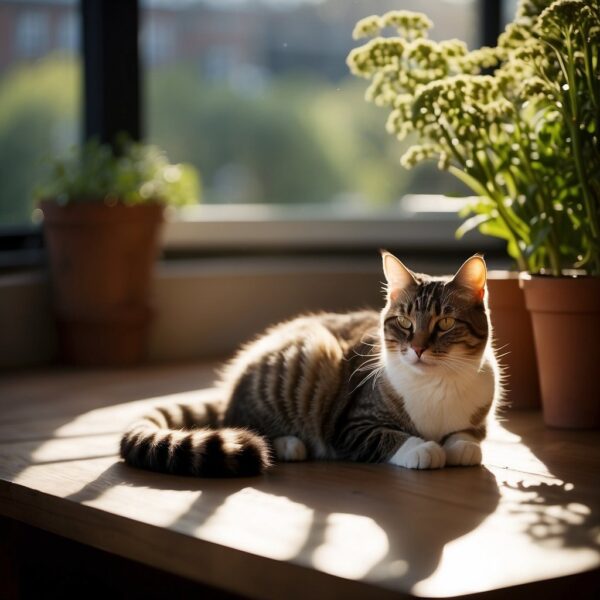
Choosing and Storing Valerian cat Products
When it comes to enhancing a cat’s life with valerian, selecting the right products and storing them effectively are critical to preserving their benefits. It ensures that the cat experiences the intended effects and the products remain effective for use.
Selecting High-Quality Valerian
To select the best valerian products for a cat, one must look for high-quality sources, ensuring that they are specifically designed for feline use. The following points should be considered:
- Source: High-quality valerian root is the primary ingredient to look for, as it’s rich in the essential oils that provide the stimulating effects cats enjoy.
- Specifications: Products should clearly state that they are formulated for cats. This includes properly dosed sprays, powders, teas, and tinctures, which cater to feline preferences and safety.
- Certifications: Look for products that have been certified by animal health organizations or veterinary associations, which can serve as a mark of safety and quality.
valerian for cats Storage Tips for Maximum Potency
Effective storage is key to maintaining the potency of valerian products. To ensure maximum efficacy:
- Airtight Containers: Store valerian root and related products in airtight containers to preserve the strong odor and volatile essential oils that are attractive to cats.
- Cool and Dark: Keep these containers in a cool, dark place away from direct sunlight, as heat and light can degrade the essential oils and lessen the product’s effectiveness.
- Dry Environment: Be sure to store valerian in a dry environment to prevent moisture from spoiling the herbs or contributing to mold growth.
By meticulously following these guidelines, pet owners can provide their cats with fresh, potent valerian products, ensuring that the feline’s interactions with the herb remain safe and enjoyable.
Observable Behaviors and Reactions to Valerian
Valerian elicits distinctive responses in felines, which can be quite telling of its influence on their behavior. Recognizing these can give insight into the herb’s effects on a cat’s nervous system.
Common Responses to Valerian Exposure
Cats exhibit a range of behaviors when exposed to valerian, a phenomenon attributed to the herb’s chemical compounds that act on their sensory systems. Typical observable reactions include:
- Excitement: An initial burst of energy leading to increased playfulness.
- Rolling: Cats may roll on the ground or against the object containing valerian.
- Rubbing: It is common to observe cats rubbing their cheeks on areas where valerian is present.
- Hyperactivity: After exposure to valerian, cats may display a hyperactive demeanor, running or jumping more than usual.
These behaviors indicate that the cat is experiencing sensory stimulation.
Unusual Reactions and What They Mean
While the majority of felines enjoy valerian, occasionally some may react differently:
- Lethargy or Disinterest: A small number of cats may show no reaction or even appear less active post-exposure.
- Agitation: In rare cases, valerian may cause restlessness or discomfort.
Atypical reactions might suggest a cat’s individual sensitivity to valerian or an underlying issue that may require attention.
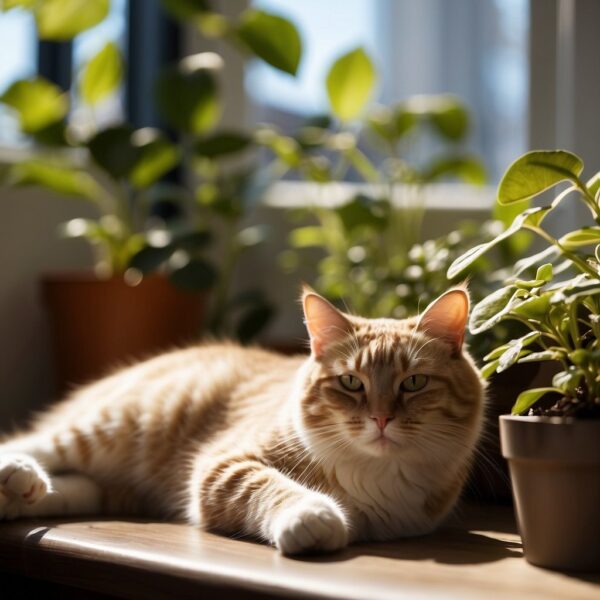
Frequently Asked Questions
This section addresses common inquiries cat parents have about the use of valerian for their feline friends.
What are the potential side effects of giving valerian to my cat?
While valerian is generally safe for cats, potential side effects include gastrointestinal upset, lethargy, and in rare cases, a paradoxical hyperactivity. Monitoring the cat’s response to valerian is important to ensure their wellbeing.
How can valerian benefit my cat’s health and behavior?
Valerian may have a stimulating effect on cats, which can be beneficial for sedentary felines. Additionally, it may reduce stress and anxiety, promoting a sense of well-being and potentially deterring unwanted behaviors.
What is the proper dosage of valerian for cats to avoid an overdose?
It’s important to follow a conservative dosage of valerian for cats, typically ranging from 1/8 to 1/4 teaspoon of the root steeped in 8 ounces of water if given as a tea. Precise dosing should be based on professional advice to prevent overdose.
Where can I purchase high-quality valerian products for my cat?
High-quality valerian products can be purchased from pet stores, holistic veterinarians, or reputable online retailers. It’s critical to choose products designed specifically for cats to ensure their safety.
How should valerian be administered to cats for optimal results?
Valerian can be administered orally, either directly or by making a tea and allowing it to cool. It can also be offered in a treat form or incorporated into a cat toy for easy ingestion.
Are there any safety concerns associated with valerian-infused cat toys?
Safety concerns for valerian-infused cat toys are minimal, but it is essential to ensure that the toy does not contain small parts that could be ingested or cause choking. The valerian potency should be suitable for feline use.